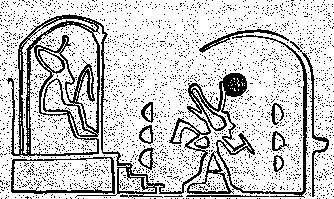|
The parallel text
in H does not have the glyph sequence below, probably because the
beginning of side b must be right and there was not enough space left on side a to
include this sequence of
glyphs.
To save space I
have not included in the table below the parallel text of Q:

In
ancient Egypt Old Pharaoh (Sun) leaves by entering the palace-chapel
('into which the god-king would retire for his changes of costume'.
There he spent his time in the 'gap', the time between the full year
and the regulated 360 day
year.
'... Five days of
illumination, called the 'Lighting of the Flame' (which in the
earlier reading of this miracle play would have followed the
quenching of the fires on the dark night of the moon when the king
was ritually slain), preceded the five days of the festival itself;
and then the solemn occasion (ad majorem dei gloriam)
commenced. The opening rites were under the patronage of Hathor. The
king, wearing the belt with her four faces and the tail of her
mighty bull, moved in numerious processions, preceded by his four
standards, from one temple to the next, presenting favors (not
offerings) to the gods ...'
In
Polynesia the natural way of leaving for the old Sun is by canoe, which
may explain why
vaha mea is followed by canoe:
 |
 |
|
Pb2-28 |
Pb2-29 |
 |
 |
|
Eb8-28 |
Eb8-29 |
The
last night moon is visible is the 28th, in the 29th night everything
is black. Not only in ancient Egypt the fires were quenched in the
dark night of the moon. |
The absent henua in Pb2-16
and Eb6-1 are important, they define what is meant by a present henua,
viz. a calendrical (well-ordered) season in the light.
Qb3-3, the glyph
parallel to Pb2-16, is drawn differently:
 |
 |
 |
 |
 |
 |
 |
|
Qb3-1 |
Qb3-2 |
Qb3-3 |
Qb3-4 |
Qb3-5 |
Qb3-6 |
Qb3-7 |
 |
 |
 |
 |
 |
 |
 |
|
Pb2-14 |
Pb2-15 |
Pb2-16 |
Pb2-17 |
Pb2-18 |
Pb2-19 |
Pb2-20 |
 |
 |
 |
 |
 |
 |
|
Qb3-8 |
Qb3-9 |
Qb3-10 |
Qb3-11 |
Qb3-12 |
Qb3-13 |
 |
 |
 |
 |
 |
|
Pb2-21 |
Pb2-22 |
Pb2-23 |
Pb2-24 |
Pb2-25 |
 |
 |
 |
 |
 |
 |
 |
 |
|
Qb3-14 |
Qb3-15 |
Qb3-16 |
Qb3-17 |
Qb3-18 |
Qb3-19 |
Qb3-20 |
Qb3-21 |
 |
 |
 |
 |
- |
- |
 |
|
Pb2-26 |
Pb2-27 |
Pb2-28 |
Pb2-29 |
Pb2-30 |
Maybe it was
intentionally drawn 'foggy' at bottom, illustrating a ghostly 'canoe'
('cooking', tao). We expect 4 'spectral' glyphs, but can see only 3.
The obvious 4th one (in a constellation of 3 + 1) is honui (Qb3-2),
possibly corresponding to the Old 'Pharaoh' in the Palace-Chapel, changing
'costumes' to emerge in splendid new year brilliance.
Beyond the later
departure by canoe (Qb3-17--18) - with 18 corresponding to the final sun
season in contrast to the 29 in P - Qb3-19 is like a rising fish, but we
recognize it here as the natural continuance of the 2 mauga glyphs in
Qb3-14 and Qb3-16. Sun has emerged from the 'mountain' (like from the giant
'fish' who swallowed Jonah) - he is outside again.
Qb3-20 also
explains that a season of orderly light now has arrived. In Qb3-21 (whatever
it means) we recognize the beginning of the 18 glyphs of order in Large
Santiago Tablet:
 |
 |
 |
 |
 |
 |
|
Sa1-101 |
Sa1-102 |
Sa1-103 |
Sa1-104 |
Sa1-201 |
Sa1-202 |
|
1 |
2 |
3 |
4 |
5 |
6 |
 |
 |
 |
 |
 |
 |
|
Sa1-203 |
Sa1-204 |
Sa1-205 |
Sa1-206 |
Sa1-207 |
Sa1-208 |
|
7 |
8 |
9 |
10 |
11 |
12 |
Beyond vaha mea
(5 as in rima) comes a henua followed by ua (7). We
can now guess that (4) may be haga rave (cfr Qb3-9), and if so, then
vaha mea may have haga rave as mouth. In contrast the mouth of
tara is not haga rave but shaped like U rather than V.


























